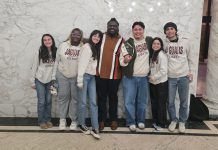According to the National Alliance to End Homelessness, there are over “11 million extremely low-income households” across the U.S. that are barely getting by, paying “at least half their income towards housing,” which increases their risk of becoming homeless drastically. And California has the largest share of these 11 million extremely low-income households with over 1.2 million at-risk families across the state according to the National Low Income Housing Coalition.

Furthermore, the cities of San Diego, Chula Vista, as well as Carlsbad account for 102,000 of these at-risk families, and there is still a need for 82,000 more affordable rental homes in these areas according to the National Low Income Housing Coalition.
Examining Chula Vista’s efforts to address homelessness, the City Council banned encampments within the city. The city is the second-largest in San Diego County, with nearly 280,000 residents, but there are also 780 homeless people in Chula Vista, according to the city’s homeless outreach team.
Mayor, John McCann, claims that this homelessness has led to safety concerns for residents and argued the city had to shut down one of its parks because there was “drug use…prostitution…[and] other criminal activity…right next to an elementary school”
“If someone is found camping or sleeping on the street, their belongings can be removed with 24-hour written notice. People running afoul of the law could face a misdemeanor charge.”
City officials say the goal of this policy intervention is supposed “to help motivate some of the homeless people to get the help they need while protecting public spaces” from crime. They assert that they are still compassionate towards homeless people in the city and will continue to regularly provide access to housing programs and drug rehabilitation, but the city must also protect public safety.
Chula Vista enacted this ban, regardless if shelters are available or not to these affected unsheltered individuals. The strengths of this recent policy are that it aligns with the governor’s priorities to address homelessness, as well as aligns with a recent landmark decision by the Supreme Court that upheld encampment bans in other states, so there is legitimacy to the city’s ban. And even though there are opponents to this ban, there are just as many people that support the ban because residents and leaders across the state have legitimate safety concerns about homeless encampments near schools and public parks.
The weaknesses and trade-offs are numerous though. The bans arguably criminalizes homelessness, especially if no shelters are available to these unsheltered homeless people. Unsheltered homeless people are much more likely to have physical conditions, mental conditions, and substance abuse conditions, so physically pushing them out of the city will only take them further from the help they need to get better. Not to mention, the mental toll that these unsheltered people have on a daily basis is only getting exacerbated by this ban because it essentially makes them feel worthless, not wanted, and even criminal for simply being homeless. No one should have to live like that. And even though this ban will reduce the visibility of homelessness in the city, which residents will like, it does not decrease the number of homeless people and does not address the underlying issue of homelessness.
In May of 2023, the city unveiled the Chula Vista Village, which consists of 65 tiny homes, each being 64-square feet, where homeless people will be fed three meals a day while having access to bathrooms, showers, and laundry facilities.
McCann and Homeless Solutions Manager Angelica Davis were extremely proud to cut the ribbon on this equity-driven solution to homelessness in Chula Vista. The mayor made sure to point out that the village’s opening “is a historical event” because “[i]t’s the first homeless shelter” in the region. Davis also asserted that she wants residents of the tiny homes to “know…that they have their basic essential needs met” and she wants residents to know their “dignity and safety” are paramount to the city.
In terms of equitable access to these tiny homes, the city has delegated the screening process and power to the Homeless Outreach Team, which is, interestingly, the same group of people that will be enforcing the encampment ban. The Homeless Outreach Team does not publicly disclose how they determine who gets to reside in the tiny home village, but it is alluded that they must be sober and free from addiction.
Keep in mind that a considerable amount of unsheltered people have a substance abuse disorder, so presumably hundreds of Chula Vista’s homeless population will be denied access to these tiny homes if this sober policy is true. So, we unfortunately do not know how equity is defined by the Homeless Outreach Team of Chula Vista or who is making the judgement call to let some unsheltered people in and not others. But, it is curious that the same officials who will be forcibly removing unsheltered people belongings, due to the encampment ban, will also be the ones to gatekeep who is let into the tiny home village.
In terms of operational success and implementation, Chula Vista has released its Impact Report providing statistics on the village’s first year of operation, from May 2023 to June 2024. There have been “73 clients enrolled” during that time, with “12 positive exits.” Only 11 housing applications have been completed and only “3 clients [have been] connected to income,” according to the report.
The average length of stay for a client is 3.3 months, but only 61% of the tiny homes are occupied, so that means over 20 of the 65 tiny homes are unused on a regular basis. Admittedly, this is just the first year of the village running, but these statistics bring into question if the $5.5 million price tag for this project has been adequately spent.
This equity-driven solution came from the desire to help unsheltered homeless people get into temporary housing and ultimately assist them to get into permanent housing, but operational evidence might indicate that this effort is not effective as originally hoped.
When the village opened, residents of Chula Vista were concerned about the total cost of the project and were skeptical of the longevity of the project. With these voiced concerns in mind, it could be possible that the city’s recent policy change regarding encampments is meant to encourage more unsheltered individuals to seek residence at the tiny home village.
So, it is reasonable to think that the less-than-stellar performance of the tiny home village at least somewhat influenced the City Council to take measures on reducing unsheltered homelessness within the city. But, if this is the case, it was a misguided one because, as analyzed before, banning encampments only alienates and displaces those unsheltered people who need assistance most. And when you combine that with the possibility that the city’s Homeless Outreach Team might be overly strict or exclusive with whom is allowed into the tiny home village, the consequence is that the city is not adequately addressing its homelessness crisis the way it thinks it is.
Jared Blackwell is an Air Force veteran born and raised in Chula Vista. He graduated from UC San Diego in 2023, and is now completing a Masters of Public Administration degree at San Diego State University.












